Strategic Marketing for Water Purification Products in Australia
VerifiedAdded on 2020/05/28
|20
|4530
|216
AI Summary
The objective of this assignment is to develop a comprehensive digital marketing strategy that leverages modern techniques for improving an organization's online presence. Students will explore various facets of digital marketing, including content creation, online advertising, social media engagement, and data analytics, to craft strategies that align with business goals. The task involves analyzing current market trends, understanding customer behavior through segmentation, and utilizing these insights to create tailored marketing campaigns. Key components include identifying target audiences, designing value cocreation processes, and implementing effective promotion strategies. Students will draw on case studies and research from sources like Hanssens & Pauwels (2016) on marketing value and Janghorban et al. (2014) on qualitative research methodologies to support their strategy development. The assignment culminates in a detailed report that outlines the proposed digital marketing plan, justifies strategic choices with data-driven insights, and anticipates potential challenges and solutions.
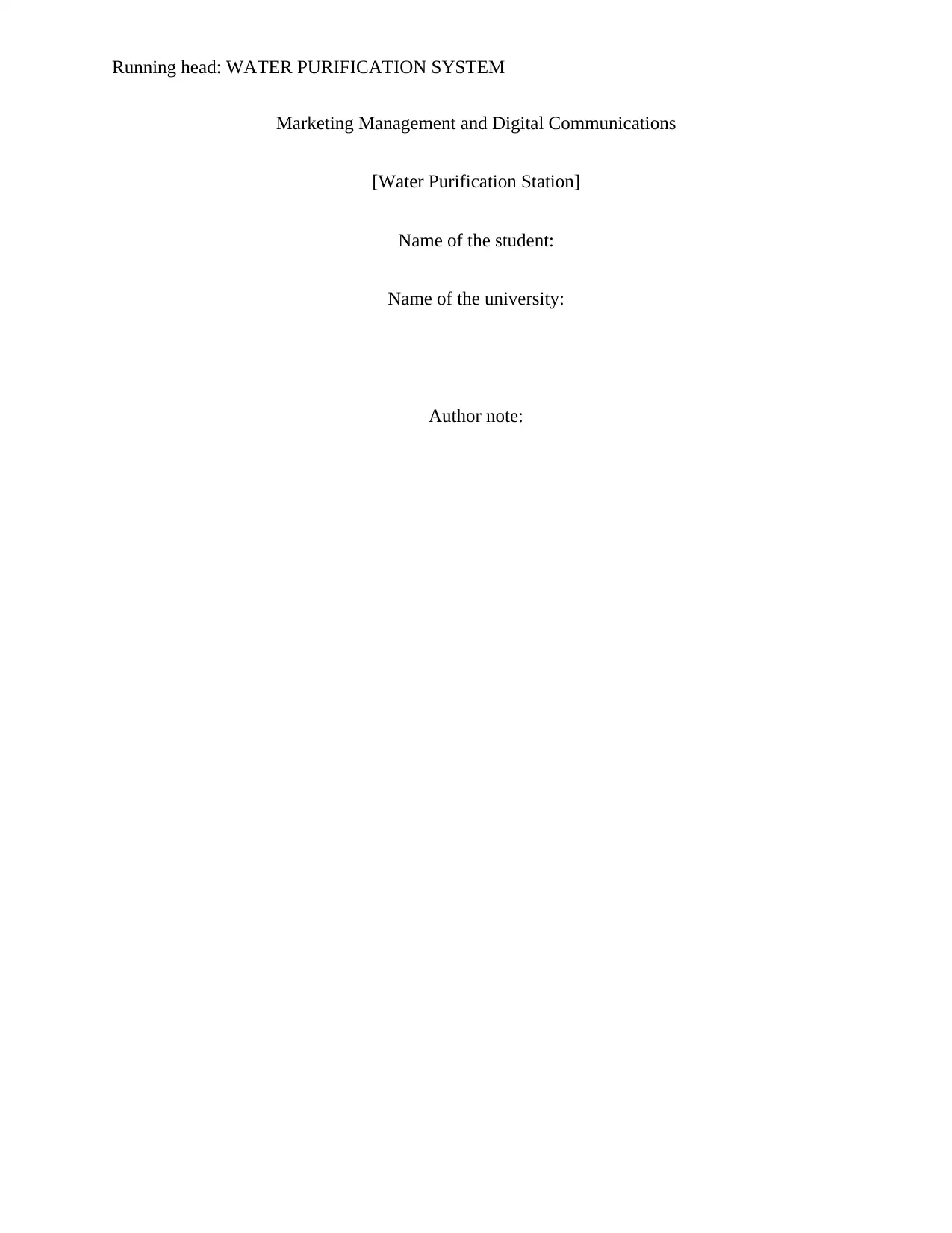
Running head: WATER PURIFICATION SYSTEM
Marketing Management and Digital Communications
[Water Purification Station]
Name of the student:
Name of the university:
Author note:
Marketing Management and Digital Communications
[Water Purification Station]
Name of the student:
Name of the university:
Author note:
Paraphrase This Document
Need a fresh take? Get an instant paraphrase of this document with our AI Paraphraser
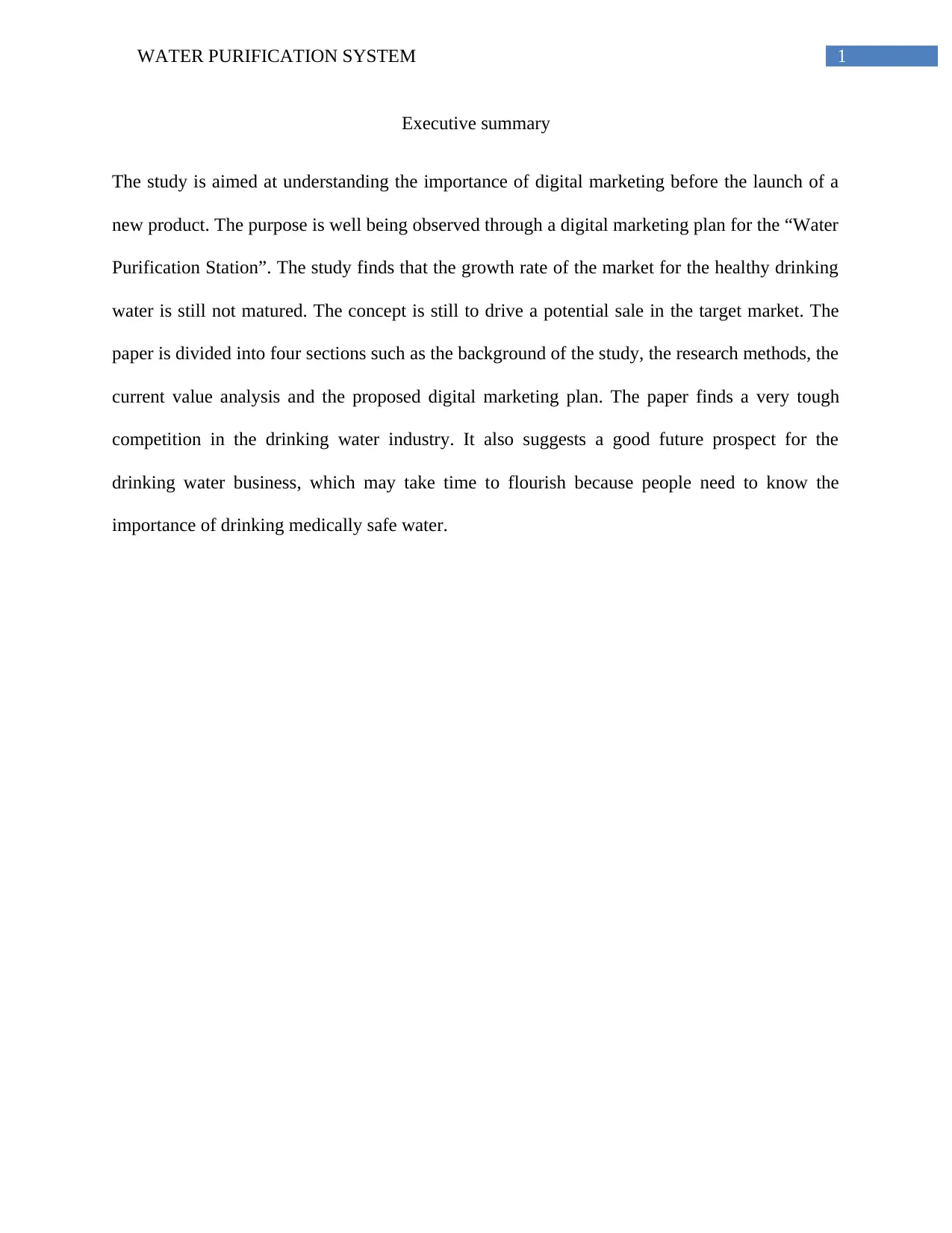
1WATER PURIFICATION SYSTEM
Executive summary
The study is aimed at understanding the importance of digital marketing before the launch of a
new product. The purpose is well being observed through a digital marketing plan for the “Water
Purification Station”. The study finds that the growth rate of the market for the healthy drinking
water is still not matured. The concept is still to drive a potential sale in the target market. The
paper is divided into four sections such as the background of the study, the research methods, the
current value analysis and the proposed digital marketing plan. The paper finds a very tough
competition in the drinking water industry. It also suggests a good future prospect for the
drinking water business, which may take time to flourish because people need to know the
importance of drinking medically safe water.
Executive summary
The study is aimed at understanding the importance of digital marketing before the launch of a
new product. The purpose is well being observed through a digital marketing plan for the “Water
Purification Station”. The study finds that the growth rate of the market for the healthy drinking
water is still not matured. The concept is still to drive a potential sale in the target market. The
paper is divided into four sections such as the background of the study, the research methods, the
current value analysis and the proposed digital marketing plan. The paper finds a very tough
competition in the drinking water industry. It also suggests a good future prospect for the
drinking water business, which may take time to flourish because people need to know the
importance of drinking medically safe water.
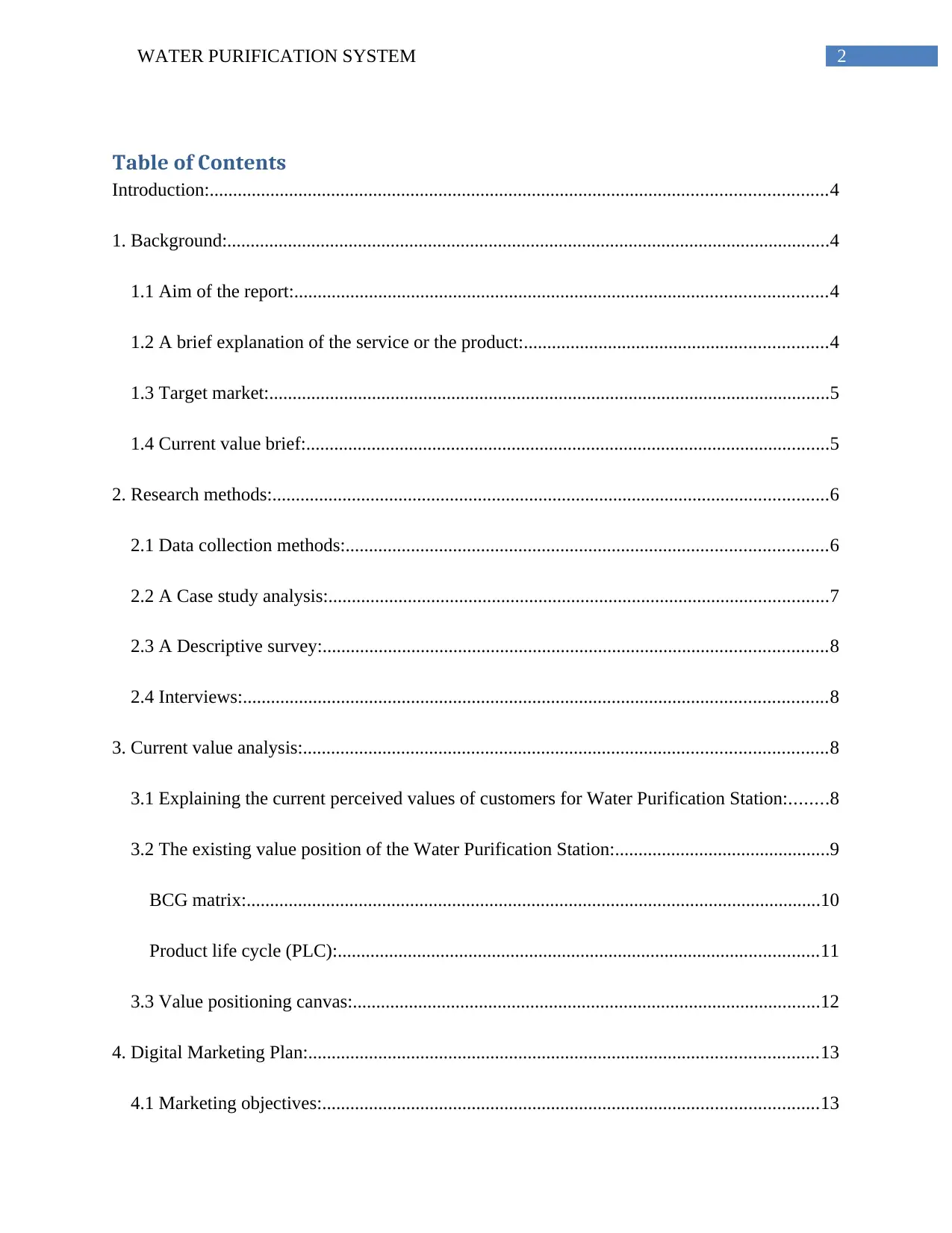
2WATER PURIFICATION SYSTEM
Table of Contents
Introduction:....................................................................................................................................4
1. Background:.................................................................................................................................4
1.1 Aim of the report:..................................................................................................................4
1.2 A brief explanation of the service or the product:.................................................................4
1.3 Target market:........................................................................................................................5
1.4 Current value brief:................................................................................................................5
2. Research methods:.......................................................................................................................6
2.1 Data collection methods:.......................................................................................................6
2.2 A Case study analysis:...........................................................................................................7
2.3 A Descriptive survey:............................................................................................................8
2.4 Interviews:.............................................................................................................................8
3. Current value analysis:................................................................................................................8
3.1 Explaining the current perceived values of customers for Water Purification Station:........8
3.2 The existing value position of the Water Purification Station:..............................................9
BCG matrix:...........................................................................................................................10
Product life cycle (PLC):.......................................................................................................11
3.3 Value positioning canvas:....................................................................................................12
4. Digital Marketing Plan:.............................................................................................................13
4.1 Marketing objectives:..........................................................................................................13
Table of Contents
Introduction:....................................................................................................................................4
1. Background:.................................................................................................................................4
1.1 Aim of the report:..................................................................................................................4
1.2 A brief explanation of the service or the product:.................................................................4
1.3 Target market:........................................................................................................................5
1.4 Current value brief:................................................................................................................5
2. Research methods:.......................................................................................................................6
2.1 Data collection methods:.......................................................................................................6
2.2 A Case study analysis:...........................................................................................................7
2.3 A Descriptive survey:............................................................................................................8
2.4 Interviews:.............................................................................................................................8
3. Current value analysis:................................................................................................................8
3.1 Explaining the current perceived values of customers for Water Purification Station:........8
3.2 The existing value position of the Water Purification Station:..............................................9
BCG matrix:...........................................................................................................................10
Product life cycle (PLC):.......................................................................................................11
3.3 Value positioning canvas:....................................................................................................12
4. Digital Marketing Plan:.............................................................................................................13
4.1 Marketing objectives:..........................................................................................................13
⊘ This is a preview!⊘
Do you want full access?
Subscribe today to unlock all pages.

Trusted by 1+ million students worldwide
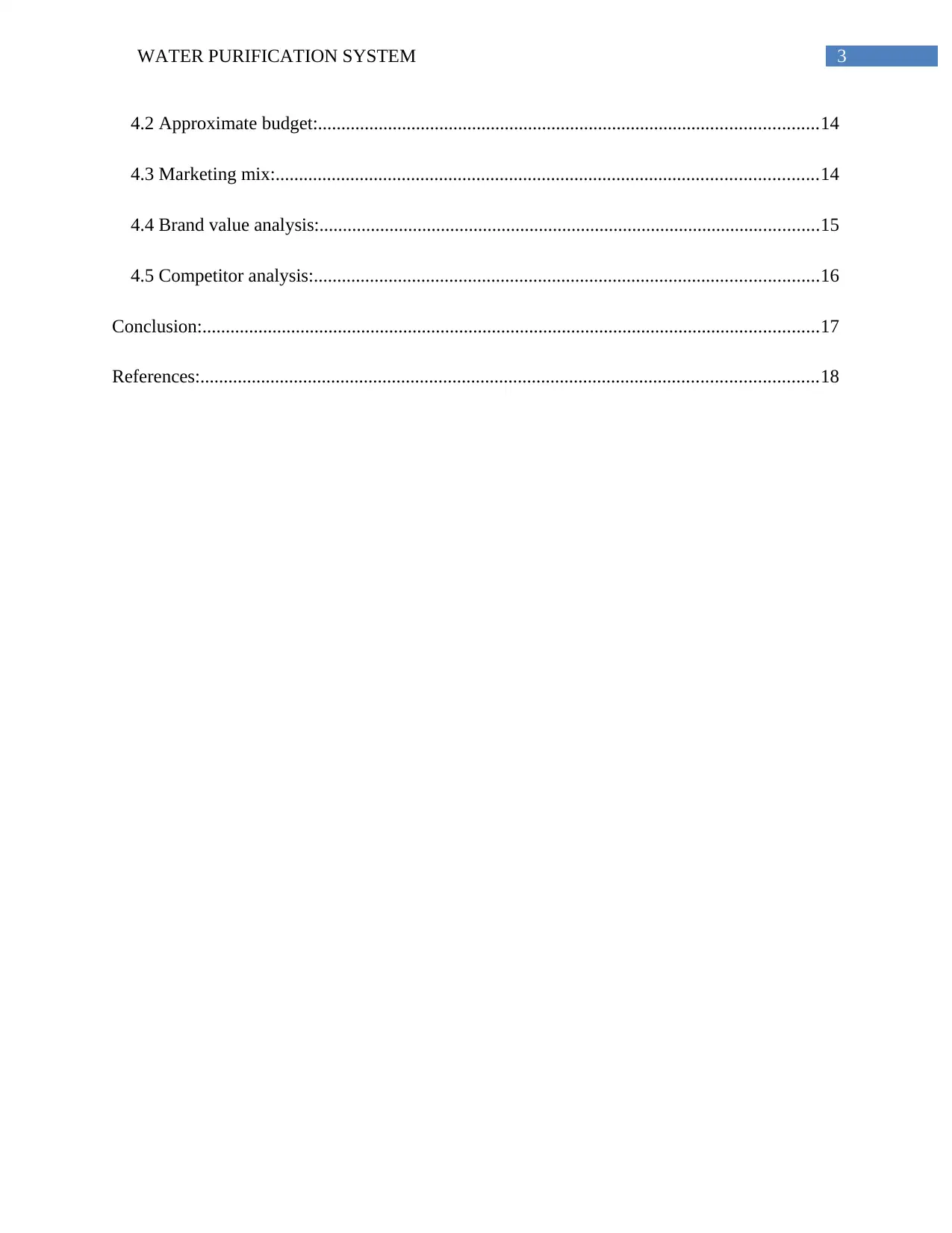
3WATER PURIFICATION SYSTEM
4.2 Approximate budget:...........................................................................................................14
4.3 Marketing mix:....................................................................................................................14
4.4 Brand value analysis:...........................................................................................................15
4.5 Competitor analysis:............................................................................................................16
Conclusion:....................................................................................................................................17
References:....................................................................................................................................18
4.2 Approximate budget:...........................................................................................................14
4.3 Marketing mix:....................................................................................................................14
4.4 Brand value analysis:...........................................................................................................15
4.5 Competitor analysis:............................................................................................................16
Conclusion:....................................................................................................................................17
References:....................................................................................................................................18
Paraphrase This Document
Need a fresh take? Get an instant paraphrase of this document with our AI Paraphraser
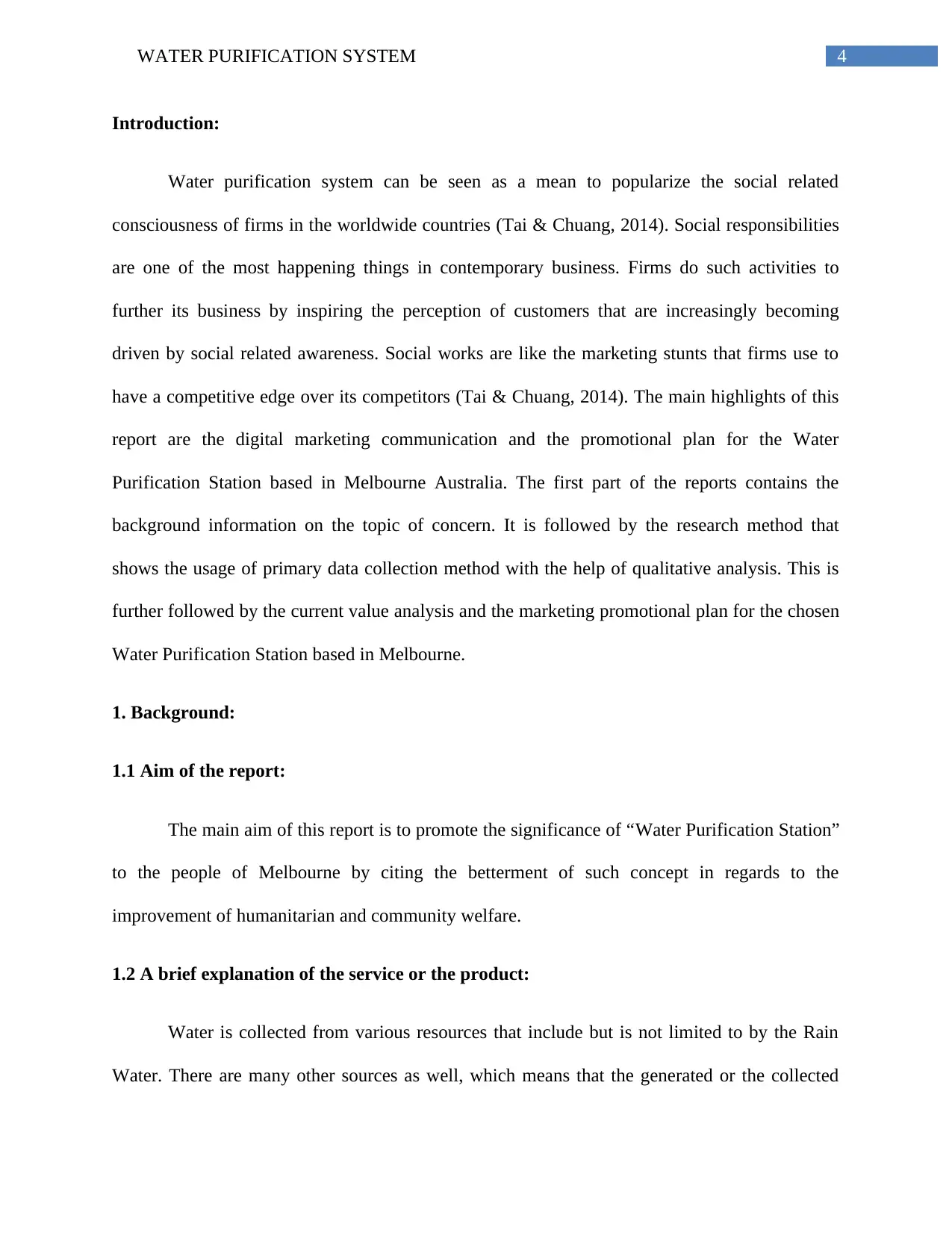
4WATER PURIFICATION SYSTEM
Introduction:
Water purification system can be seen as a mean to popularize the social related
consciousness of firms in the worldwide countries (Tai & Chuang, 2014). Social responsibilities
are one of the most happening things in contemporary business. Firms do such activities to
further its business by inspiring the perception of customers that are increasingly becoming
driven by social related awareness. Social works are like the marketing stunts that firms use to
have a competitive edge over its competitors (Tai & Chuang, 2014). The main highlights of this
report are the digital marketing communication and the promotional plan for the Water
Purification Station based in Melbourne Australia. The first part of the reports contains the
background information on the topic of concern. It is followed by the research method that
shows the usage of primary data collection method with the help of qualitative analysis. This is
further followed by the current value analysis and the marketing promotional plan for the chosen
Water Purification Station based in Melbourne.
1. Background:
1.1 Aim of the report:
The main aim of this report is to promote the significance of “Water Purification Station”
to the people of Melbourne by citing the betterment of such concept in regards to the
improvement of humanitarian and community welfare.
1.2 A brief explanation of the service or the product:
Water is collected from various resources that include but is not limited to by the Rain
Water. There are many other sources as well, which means that the generated or the collected
Introduction:
Water purification system can be seen as a mean to popularize the social related
consciousness of firms in the worldwide countries (Tai & Chuang, 2014). Social responsibilities
are one of the most happening things in contemporary business. Firms do such activities to
further its business by inspiring the perception of customers that are increasingly becoming
driven by social related awareness. Social works are like the marketing stunts that firms use to
have a competitive edge over its competitors (Tai & Chuang, 2014). The main highlights of this
report are the digital marketing communication and the promotional plan for the Water
Purification Station based in Melbourne Australia. The first part of the reports contains the
background information on the topic of concern. It is followed by the research method that
shows the usage of primary data collection method with the help of qualitative analysis. This is
further followed by the current value analysis and the marketing promotional plan for the chosen
Water Purification Station based in Melbourne.
1. Background:
1.1 Aim of the report:
The main aim of this report is to promote the significance of “Water Purification Station”
to the people of Melbourne by citing the betterment of such concept in regards to the
improvement of humanitarian and community welfare.
1.2 A brief explanation of the service or the product:
Water is collected from various resources that include but is not limited to by the Rain
Water. There are many other sources as well, which means that the generated or the collected
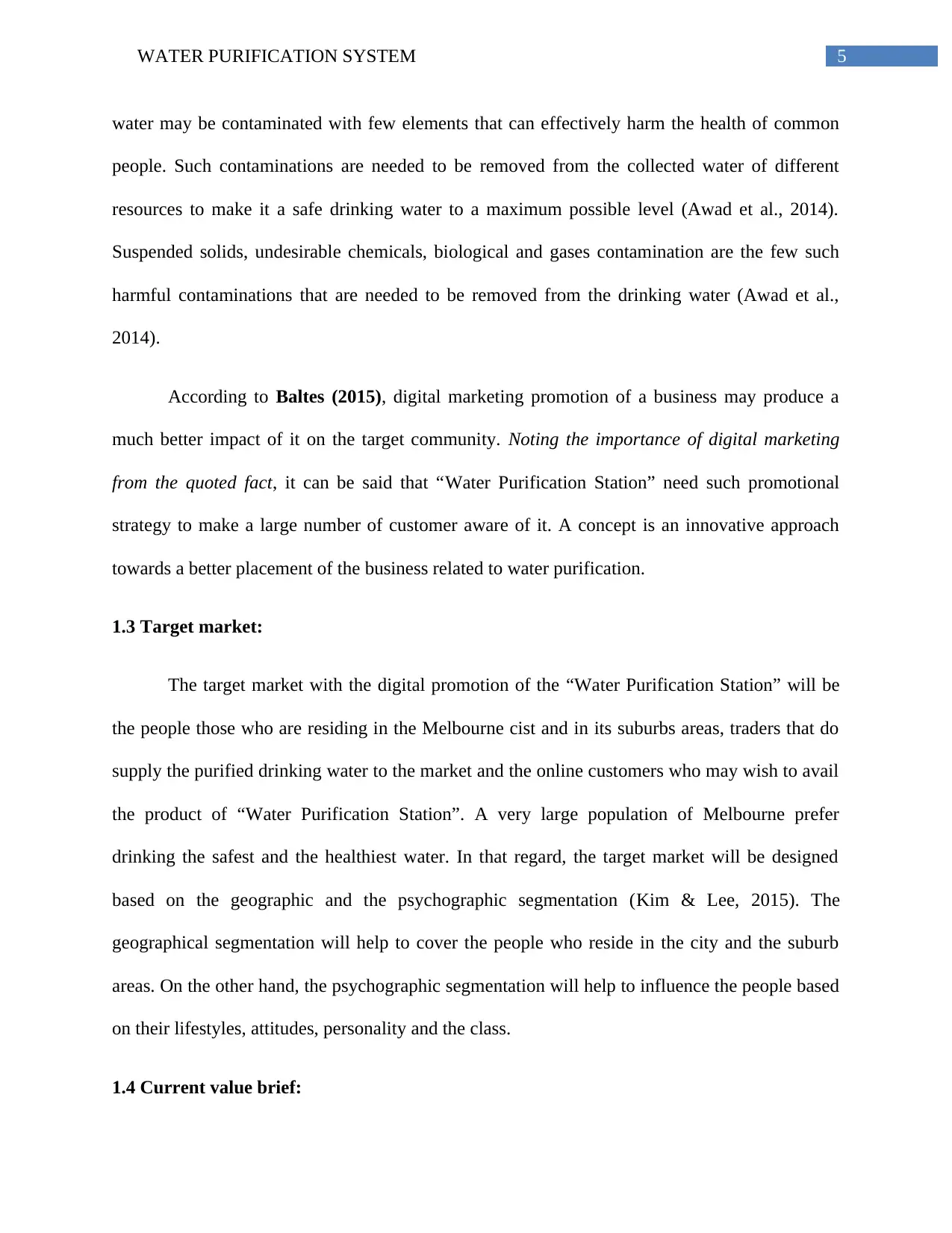
5WATER PURIFICATION SYSTEM
water may be contaminated with few elements that can effectively harm the health of common
people. Such contaminations are needed to be removed from the collected water of different
resources to make it a safe drinking water to a maximum possible level (Awad et al., 2014).
Suspended solids, undesirable chemicals, biological and gases contamination are the few such
harmful contaminations that are needed to be removed from the drinking water (Awad et al.,
2014).
According to Baltes (2015), digital marketing promotion of a business may produce a
much better impact of it on the target community. Noting the importance of digital marketing
from the quoted fact, it can be said that “Water Purification Station” need such promotional
strategy to make a large number of customer aware of it. A concept is an innovative approach
towards a better placement of the business related to water purification.
1.3 Target market:
The target market with the digital promotion of the “Water Purification Station” will be
the people those who are residing in the Melbourne cist and in its suburbs areas, traders that do
supply the purified drinking water to the market and the online customers who may wish to avail
the product of “Water Purification Station”. A very large population of Melbourne prefer
drinking the safest and the healthiest water. In that regard, the target market will be designed
based on the geographic and the psychographic segmentation (Kim & Lee, 2015). The
geographical segmentation will help to cover the people who reside in the city and the suburb
areas. On the other hand, the psychographic segmentation will help to influence the people based
on their lifestyles, attitudes, personality and the class.
1.4 Current value brief:
water may be contaminated with few elements that can effectively harm the health of common
people. Such contaminations are needed to be removed from the collected water of different
resources to make it a safe drinking water to a maximum possible level (Awad et al., 2014).
Suspended solids, undesirable chemicals, biological and gases contamination are the few such
harmful contaminations that are needed to be removed from the drinking water (Awad et al.,
2014).
According to Baltes (2015), digital marketing promotion of a business may produce a
much better impact of it on the target community. Noting the importance of digital marketing
from the quoted fact, it can be said that “Water Purification Station” need such promotional
strategy to make a large number of customer aware of it. A concept is an innovative approach
towards a better placement of the business related to water purification.
1.3 Target market:
The target market with the digital promotion of the “Water Purification Station” will be
the people those who are residing in the Melbourne cist and in its suburbs areas, traders that do
supply the purified drinking water to the market and the online customers who may wish to avail
the product of “Water Purification Station”. A very large population of Melbourne prefer
drinking the safest and the healthiest water. In that regard, the target market will be designed
based on the geographic and the psychographic segmentation (Kim & Lee, 2015). The
geographical segmentation will help to cover the people who reside in the city and the suburb
areas. On the other hand, the psychographic segmentation will help to influence the people based
on their lifestyles, attitudes, personality and the class.
1.4 Current value brief:
⊘ This is a preview!⊘
Do you want full access?
Subscribe today to unlock all pages.

Trusted by 1+ million students worldwide
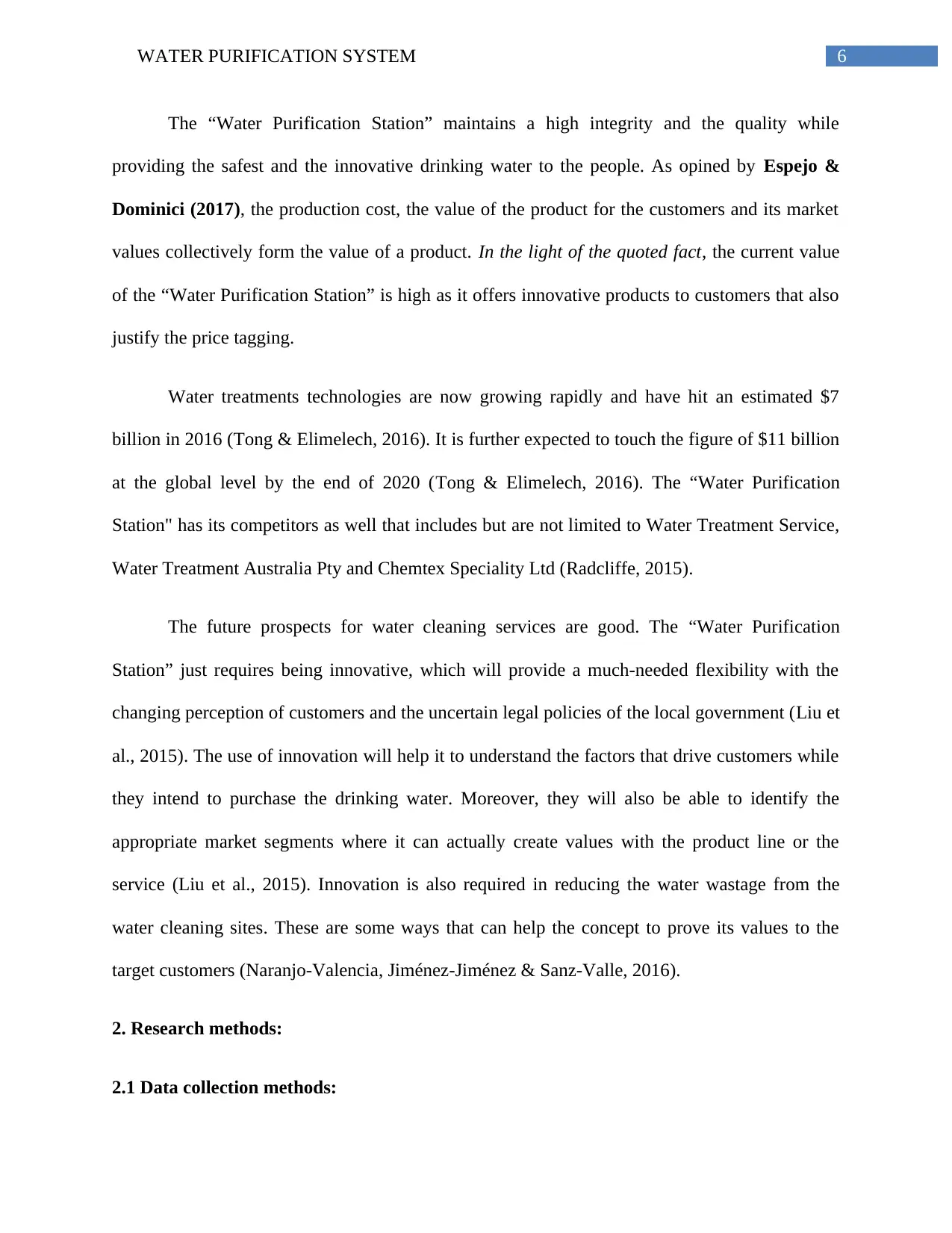
6WATER PURIFICATION SYSTEM
The “Water Purification Station” maintains a high integrity and the quality while
providing the safest and the innovative drinking water to the people. As opined by Espejo &
Dominici (2017), the production cost, the value of the product for the customers and its market
values collectively form the value of a product. In the light of the quoted fact, the current value
of the “Water Purification Station” is high as it offers innovative products to customers that also
justify the price tagging.
Water treatments technologies are now growing rapidly and have hit an estimated $7
billion in 2016 (Tong & Elimelech, 2016). It is further expected to touch the figure of $11 billion
at the global level by the end of 2020 (Tong & Elimelech, 2016). The “Water Purification
Station" has its competitors as well that includes but are not limited to Water Treatment Service,
Water Treatment Australia Pty and Chemtex Speciality Ltd (Radcliffe, 2015).
The future prospects for water cleaning services are good. The “Water Purification
Station” just requires being innovative, which will provide a much-needed flexibility with the
changing perception of customers and the uncertain legal policies of the local government (Liu et
al., 2015). The use of innovation will help it to understand the factors that drive customers while
they intend to purchase the drinking water. Moreover, they will also be able to identify the
appropriate market segments where it can actually create values with the product line or the
service (Liu et al., 2015). Innovation is also required in reducing the water wastage from the
water cleaning sites. These are some ways that can help the concept to prove its values to the
target customers (Naranjo-Valencia, Jiménez-Jiménez & Sanz-Valle, 2016).
2. Research methods:
2.1 Data collection methods:
The “Water Purification Station” maintains a high integrity and the quality while
providing the safest and the innovative drinking water to the people. As opined by Espejo &
Dominici (2017), the production cost, the value of the product for the customers and its market
values collectively form the value of a product. In the light of the quoted fact, the current value
of the “Water Purification Station” is high as it offers innovative products to customers that also
justify the price tagging.
Water treatments technologies are now growing rapidly and have hit an estimated $7
billion in 2016 (Tong & Elimelech, 2016). It is further expected to touch the figure of $11 billion
at the global level by the end of 2020 (Tong & Elimelech, 2016). The “Water Purification
Station" has its competitors as well that includes but are not limited to Water Treatment Service,
Water Treatment Australia Pty and Chemtex Speciality Ltd (Radcliffe, 2015).
The future prospects for water cleaning services are good. The “Water Purification
Station” just requires being innovative, which will provide a much-needed flexibility with the
changing perception of customers and the uncertain legal policies of the local government (Liu et
al., 2015). The use of innovation will help it to understand the factors that drive customers while
they intend to purchase the drinking water. Moreover, they will also be able to identify the
appropriate market segments where it can actually create values with the product line or the
service (Liu et al., 2015). Innovation is also required in reducing the water wastage from the
water cleaning sites. These are some ways that can help the concept to prove its values to the
target customers (Naranjo-Valencia, Jiménez-Jiménez & Sanz-Valle, 2016).
2. Research methods:
2.1 Data collection methods:
Paraphrase This Document
Need a fresh take? Get an instant paraphrase of this document with our AI Paraphraser
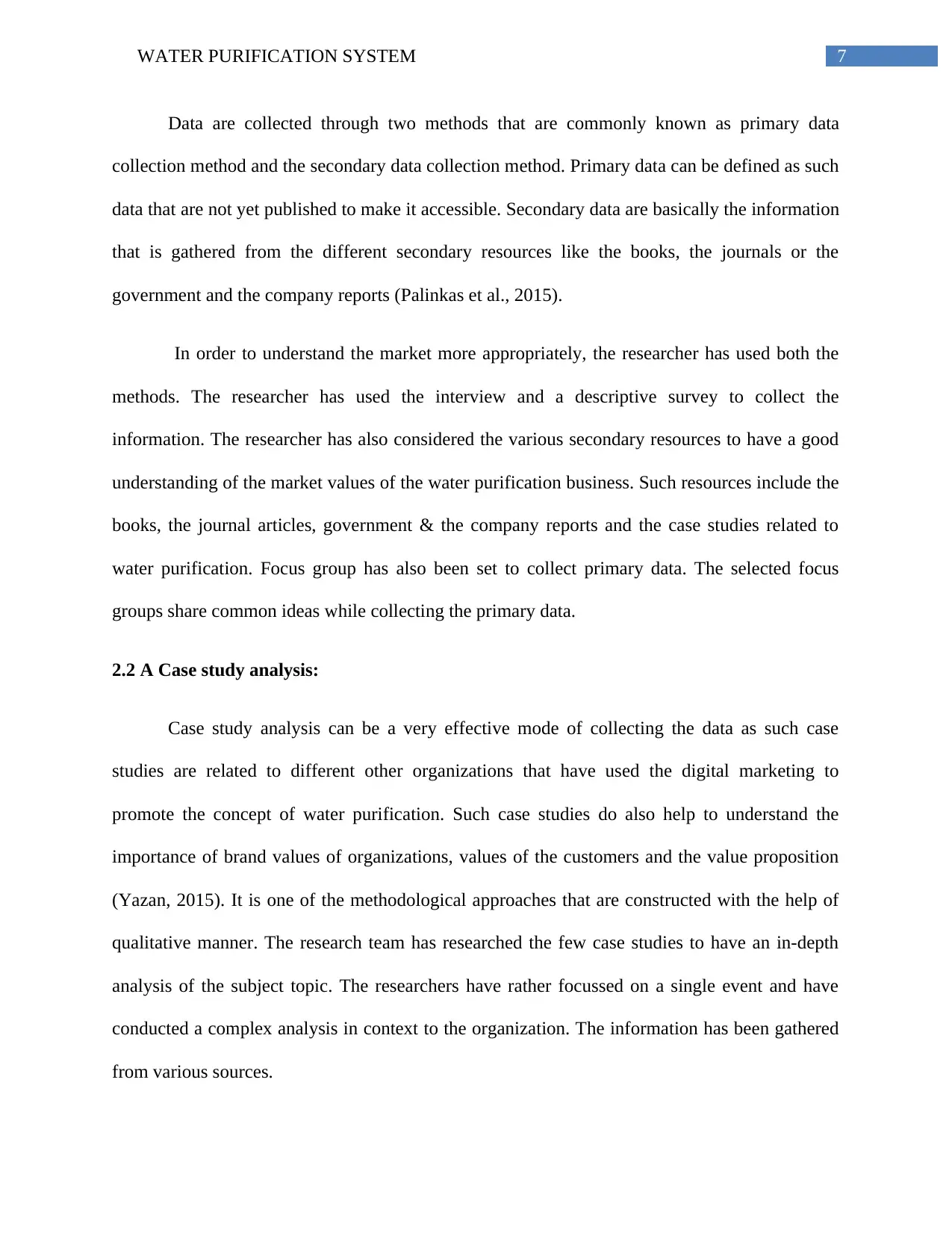
7WATER PURIFICATION SYSTEM
Data are collected through two methods that are commonly known as primary data
collection method and the secondary data collection method. Primary data can be defined as such
data that are not yet published to make it accessible. Secondary data are basically the information
that is gathered from the different secondary resources like the books, the journals or the
government and the company reports (Palinkas et al., 2015).
In order to understand the market more appropriately, the researcher has used both the
methods. The researcher has used the interview and a descriptive survey to collect the
information. The researcher has also considered the various secondary resources to have a good
understanding of the market values of the water purification business. Such resources include the
books, the journal articles, government & the company reports and the case studies related to
water purification. Focus group has also been set to collect primary data. The selected focus
groups share common ideas while collecting the primary data.
2.2 A Case study analysis:
Case study analysis can be a very effective mode of collecting the data as such case
studies are related to different other organizations that have used the digital marketing to
promote the concept of water purification. Such case studies do also help to understand the
importance of brand values of organizations, values of the customers and the value proposition
(Yazan, 2015). It is one of the methodological approaches that are constructed with the help of
qualitative manner. The research team has researched the few case studies to have an in-depth
analysis of the subject topic. The researchers have rather focussed on a single event and have
conducted a complex analysis in context to the organization. The information has been gathered
from various sources.
Data are collected through two methods that are commonly known as primary data
collection method and the secondary data collection method. Primary data can be defined as such
data that are not yet published to make it accessible. Secondary data are basically the information
that is gathered from the different secondary resources like the books, the journals or the
government and the company reports (Palinkas et al., 2015).
In order to understand the market more appropriately, the researcher has used both the
methods. The researcher has used the interview and a descriptive survey to collect the
information. The researcher has also considered the various secondary resources to have a good
understanding of the market values of the water purification business. Such resources include the
books, the journal articles, government & the company reports and the case studies related to
water purification. Focus group has also been set to collect primary data. The selected focus
groups share common ideas while collecting the primary data.
2.2 A Case study analysis:
Case study analysis can be a very effective mode of collecting the data as such case
studies are related to different other organizations that have used the digital marketing to
promote the concept of water purification. Such case studies do also help to understand the
importance of brand values of organizations, values of the customers and the value proposition
(Yazan, 2015). It is one of the methodological approaches that are constructed with the help of
qualitative manner. The research team has researched the few case studies to have an in-depth
analysis of the subject topic. The researchers have rather focussed on a single event and have
conducted a complex analysis in context to the organization. The information has been gathered
from various sources.
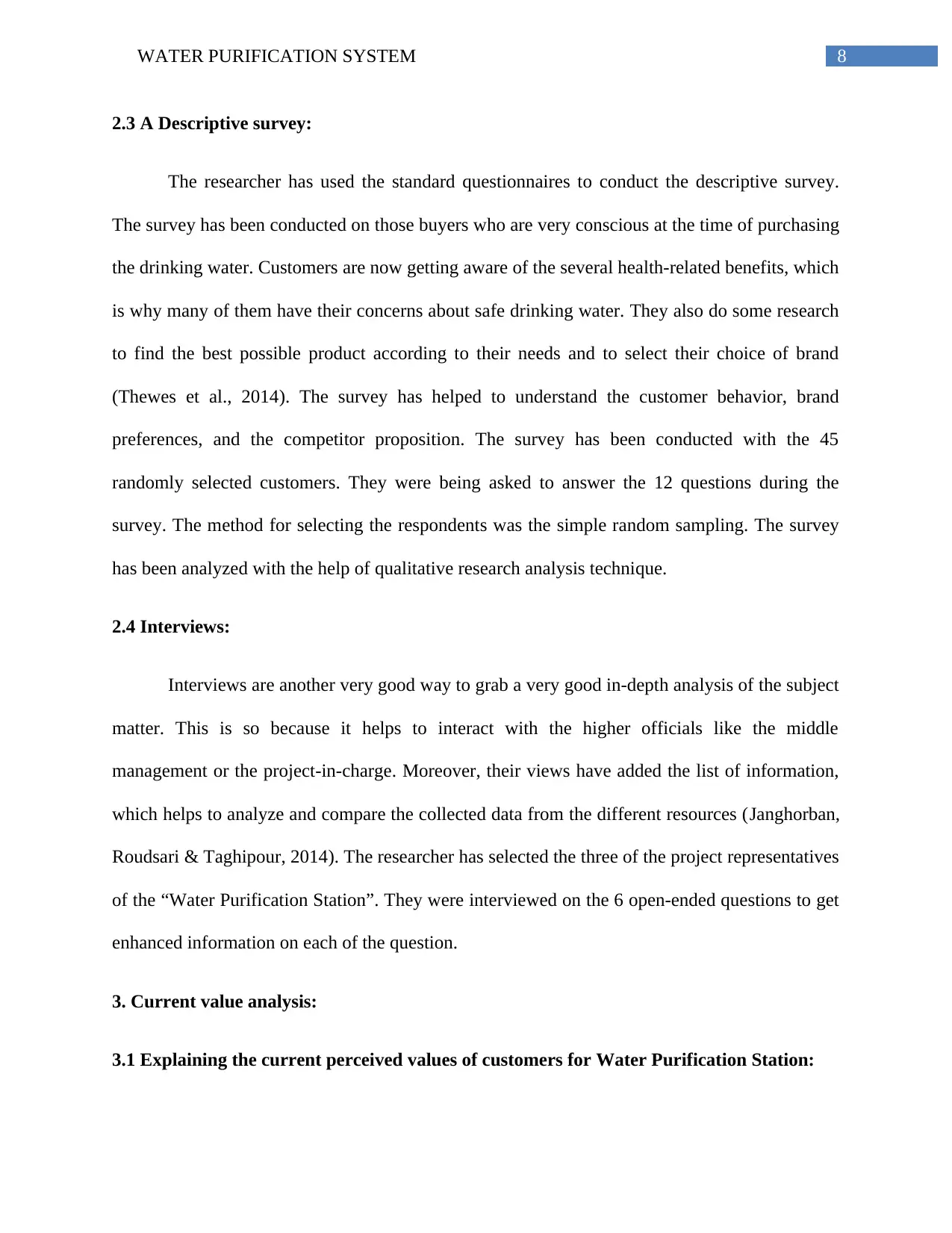
8WATER PURIFICATION SYSTEM
2.3 A Descriptive survey:
The researcher has used the standard questionnaires to conduct the descriptive survey.
The survey has been conducted on those buyers who are very conscious at the time of purchasing
the drinking water. Customers are now getting aware of the several health-related benefits, which
is why many of them have their concerns about safe drinking water. They also do some research
to find the best possible product according to their needs and to select their choice of brand
(Thewes et al., 2014). The survey has helped to understand the customer behavior, brand
preferences, and the competitor proposition. The survey has been conducted with the 45
randomly selected customers. They were being asked to answer the 12 questions during the
survey. The method for selecting the respondents was the simple random sampling. The survey
has been analyzed with the help of qualitative research analysis technique.
2.4 Interviews:
Interviews are another very good way to grab a very good in-depth analysis of the subject
matter. This is so because it helps to interact with the higher officials like the middle
management or the project-in-charge. Moreover, their views have added the list of information,
which helps to analyze and compare the collected data from the different resources (Janghorban,
Roudsari & Taghipour, 2014). The researcher has selected the three of the project representatives
of the “Water Purification Station”. They were interviewed on the 6 open-ended questions to get
enhanced information on each of the question.
3. Current value analysis:
3.1 Explaining the current perceived values of customers for Water Purification Station:
2.3 A Descriptive survey:
The researcher has used the standard questionnaires to conduct the descriptive survey.
The survey has been conducted on those buyers who are very conscious at the time of purchasing
the drinking water. Customers are now getting aware of the several health-related benefits, which
is why many of them have their concerns about safe drinking water. They also do some research
to find the best possible product according to their needs and to select their choice of brand
(Thewes et al., 2014). The survey has helped to understand the customer behavior, brand
preferences, and the competitor proposition. The survey has been conducted with the 45
randomly selected customers. They were being asked to answer the 12 questions during the
survey. The method for selecting the respondents was the simple random sampling. The survey
has been analyzed with the help of qualitative research analysis technique.
2.4 Interviews:
Interviews are another very good way to grab a very good in-depth analysis of the subject
matter. This is so because it helps to interact with the higher officials like the middle
management or the project-in-charge. Moreover, their views have added the list of information,
which helps to analyze and compare the collected data from the different resources (Janghorban,
Roudsari & Taghipour, 2014). The researcher has selected the three of the project representatives
of the “Water Purification Station”. They were interviewed on the 6 open-ended questions to get
enhanced information on each of the question.
3. Current value analysis:
3.1 Explaining the current perceived values of customers for Water Purification Station:
⊘ This is a preview!⊘
Do you want full access?
Subscribe today to unlock all pages.

Trusted by 1+ million students worldwide
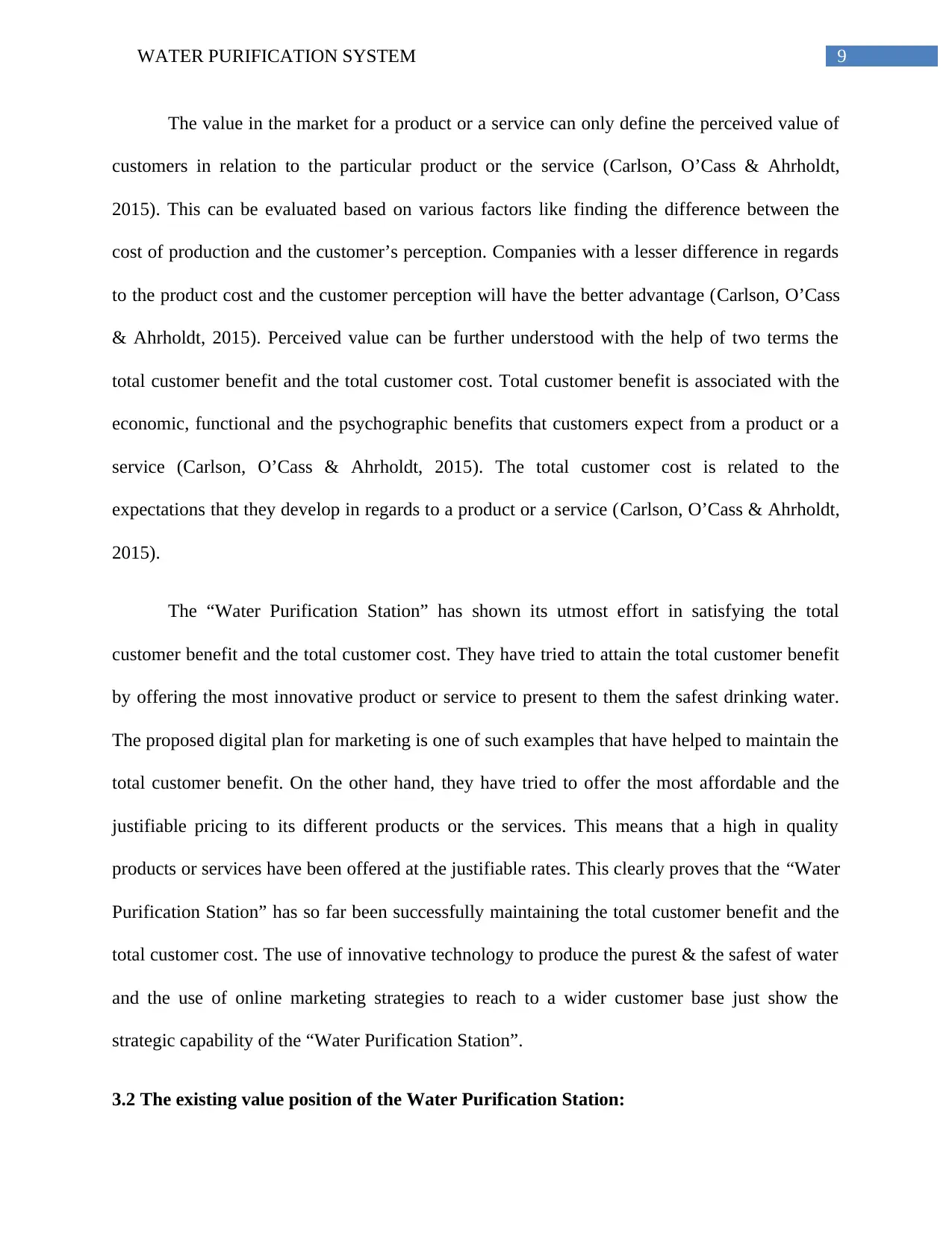
9WATER PURIFICATION SYSTEM
The value in the market for a product or a service can only define the perceived value of
customers in relation to the particular product or the service (Carlson, O’Cass & Ahrholdt,
2015). This can be evaluated based on various factors like finding the difference between the
cost of production and the customer’s perception. Companies with a lesser difference in regards
to the product cost and the customer perception will have the better advantage (Carlson, O’Cass
& Ahrholdt, 2015). Perceived value can be further understood with the help of two terms the
total customer benefit and the total customer cost. Total customer benefit is associated with the
economic, functional and the psychographic benefits that customers expect from a product or a
service (Carlson, O’Cass & Ahrholdt, 2015). The total customer cost is related to the
expectations that they develop in regards to a product or a service (Carlson, O’Cass & Ahrholdt,
2015).
The “Water Purification Station” has shown its utmost effort in satisfying the total
customer benefit and the total customer cost. They have tried to attain the total customer benefit
by offering the most innovative product or service to present to them the safest drinking water.
The proposed digital plan for marketing is one of such examples that have helped to maintain the
total customer benefit. On the other hand, they have tried to offer the most affordable and the
justifiable pricing to its different products or the services. This means that a high in quality
products or services have been offered at the justifiable rates. This clearly proves that the “Water
Purification Station” has so far been successfully maintaining the total customer benefit and the
total customer cost. The use of innovative technology to produce the purest & the safest of water
and the use of online marketing strategies to reach to a wider customer base just show the
strategic capability of the “Water Purification Station”.
3.2 The existing value position of the Water Purification Station:
The value in the market for a product or a service can only define the perceived value of
customers in relation to the particular product or the service (Carlson, O’Cass & Ahrholdt,
2015). This can be evaluated based on various factors like finding the difference between the
cost of production and the customer’s perception. Companies with a lesser difference in regards
to the product cost and the customer perception will have the better advantage (Carlson, O’Cass
& Ahrholdt, 2015). Perceived value can be further understood with the help of two terms the
total customer benefit and the total customer cost. Total customer benefit is associated with the
economic, functional and the psychographic benefits that customers expect from a product or a
service (Carlson, O’Cass & Ahrholdt, 2015). The total customer cost is related to the
expectations that they develop in regards to a product or a service (Carlson, O’Cass & Ahrholdt,
2015).
The “Water Purification Station” has shown its utmost effort in satisfying the total
customer benefit and the total customer cost. They have tried to attain the total customer benefit
by offering the most innovative product or service to present to them the safest drinking water.
The proposed digital plan for marketing is one of such examples that have helped to maintain the
total customer benefit. On the other hand, they have tried to offer the most affordable and the
justifiable pricing to its different products or the services. This means that a high in quality
products or services have been offered at the justifiable rates. This clearly proves that the “Water
Purification Station” has so far been successfully maintaining the total customer benefit and the
total customer cost. The use of innovative technology to produce the purest & the safest of water
and the use of online marketing strategies to reach to a wider customer base just show the
strategic capability of the “Water Purification Station”.
3.2 The existing value position of the Water Purification Station:
Paraphrase This Document
Need a fresh take? Get an instant paraphrase of this document with our AI Paraphraser
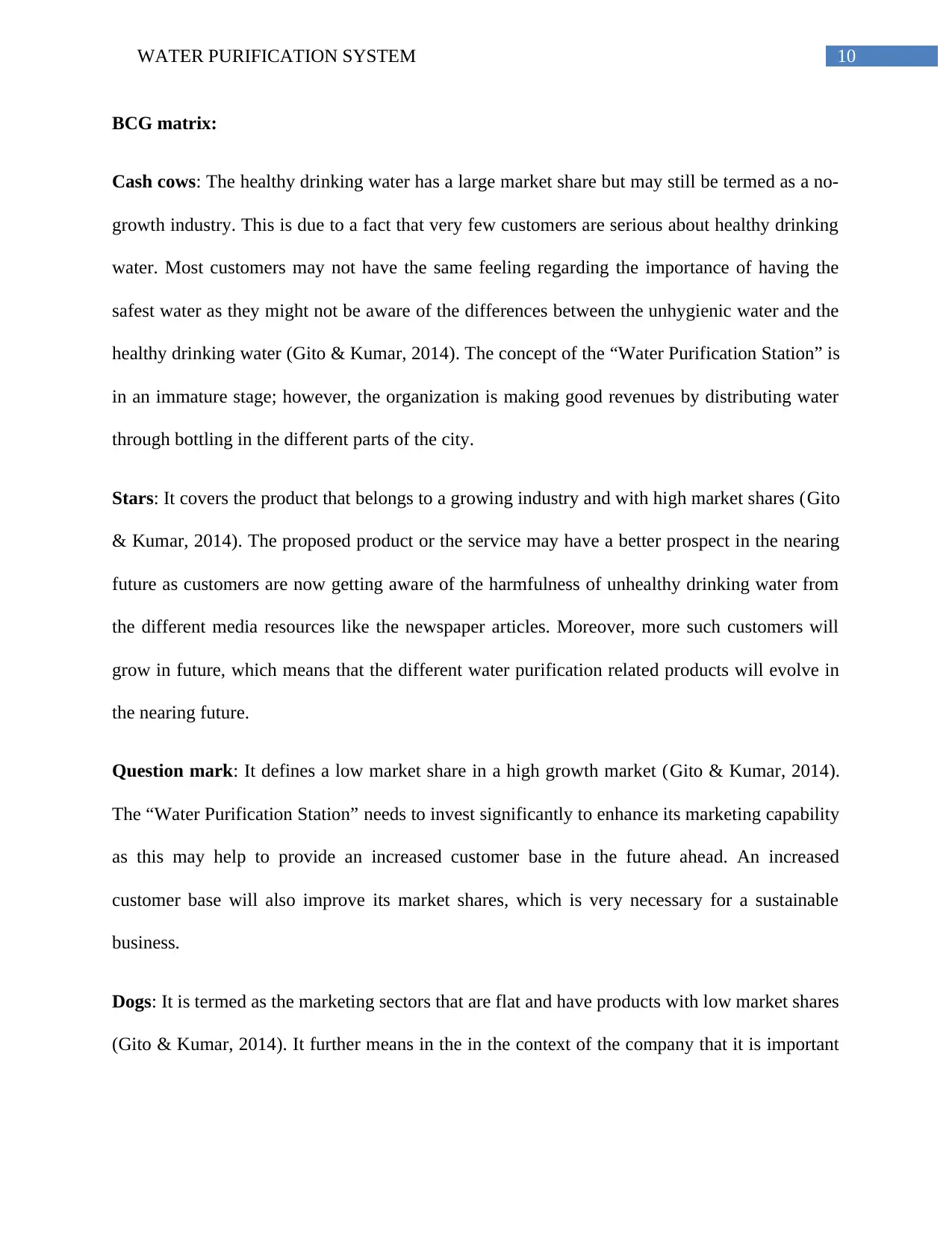
10WATER PURIFICATION SYSTEM
BCG matrix:
Cash cows: The healthy drinking water has a large market share but may still be termed as a no-
growth industry. This is due to a fact that very few customers are serious about healthy drinking
water. Most customers may not have the same feeling regarding the importance of having the
safest water as they might not be aware of the differences between the unhygienic water and the
healthy drinking water (Gito & Kumar, 2014). The concept of the “Water Purification Station” is
in an immature stage; however, the organization is making good revenues by distributing water
through bottling in the different parts of the city.
Stars: It covers the product that belongs to a growing industry and with high market shares (Gito
& Kumar, 2014). The proposed product or the service may have a better prospect in the nearing
future as customers are now getting aware of the harmfulness of unhealthy drinking water from
the different media resources like the newspaper articles. Moreover, more such customers will
grow in future, which means that the different water purification related products will evolve in
the nearing future.
Question mark: It defines a low market share in a high growth market (Gito & Kumar, 2014).
The “Water Purification Station” needs to invest significantly to enhance its marketing capability
as this may help to provide an increased customer base in the future ahead. An increased
customer base will also improve its market shares, which is very necessary for a sustainable
business.
Dogs: It is termed as the marketing sectors that are flat and have products with low market shares
(Gito & Kumar, 2014). It further means in the in the context of the company that it is important
BCG matrix:
Cash cows: The healthy drinking water has a large market share but may still be termed as a no-
growth industry. This is due to a fact that very few customers are serious about healthy drinking
water. Most customers may not have the same feeling regarding the importance of having the
safest water as they might not be aware of the differences between the unhygienic water and the
healthy drinking water (Gito & Kumar, 2014). The concept of the “Water Purification Station” is
in an immature stage; however, the organization is making good revenues by distributing water
through bottling in the different parts of the city.
Stars: It covers the product that belongs to a growing industry and with high market shares (Gito
& Kumar, 2014). The proposed product or the service may have a better prospect in the nearing
future as customers are now getting aware of the harmfulness of unhealthy drinking water from
the different media resources like the newspaper articles. Moreover, more such customers will
grow in future, which means that the different water purification related products will evolve in
the nearing future.
Question mark: It defines a low market share in a high growth market (Gito & Kumar, 2014).
The “Water Purification Station” needs to invest significantly to enhance its marketing capability
as this may help to provide an increased customer base in the future ahead. An increased
customer base will also improve its market shares, which is very necessary for a sustainable
business.
Dogs: It is termed as the marketing sectors that are flat and have products with low market shares
(Gito & Kumar, 2014). It further means in the in the context of the company that it is important
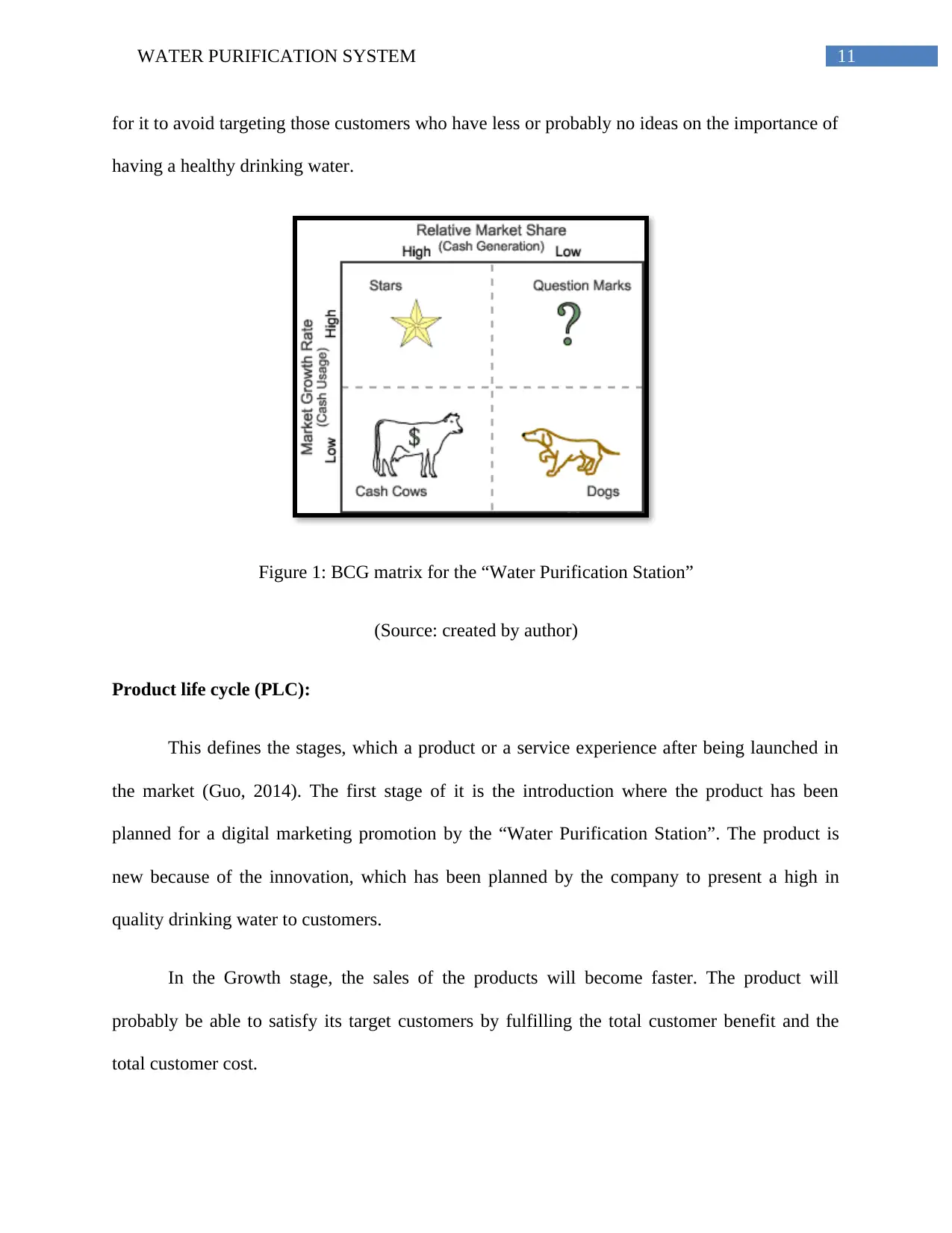
11WATER PURIFICATION SYSTEM
for it to avoid targeting those customers who have less or probably no ideas on the importance of
having a healthy drinking water.
Figure 1: BCG matrix for the “Water Purification Station”
(Source: created by author)
Product life cycle (PLC):
This defines the stages, which a product or a service experience after being launched in
the market (Guo, 2014). The first stage of it is the introduction where the product has been
planned for a digital marketing promotion by the “Water Purification Station”. The product is
new because of the innovation, which has been planned by the company to present a high in
quality drinking water to customers.
In the Growth stage, the sales of the products will become faster. The product will
probably be able to satisfy its target customers by fulfilling the total customer benefit and the
total customer cost.
for it to avoid targeting those customers who have less or probably no ideas on the importance of
having a healthy drinking water.
Figure 1: BCG matrix for the “Water Purification Station”
(Source: created by author)
Product life cycle (PLC):
This defines the stages, which a product or a service experience after being launched in
the market (Guo, 2014). The first stage of it is the introduction where the product has been
planned for a digital marketing promotion by the “Water Purification Station”. The product is
new because of the innovation, which has been planned by the company to present a high in
quality drinking water to customers.
In the Growth stage, the sales of the products will become faster. The product will
probably be able to satisfy its target customers by fulfilling the total customer benefit and the
total customer cost.
⊘ This is a preview!⊘
Do you want full access?
Subscribe today to unlock all pages.

Trusted by 1+ million students worldwide
1 out of 20
Related Documents
Your All-in-One AI-Powered Toolkit for Academic Success.
+13062052269
info@desklib.com
Available 24*7 on WhatsApp / Email
![[object Object]](/_next/static/media/star-bottom.7253800d.svg)
Unlock your academic potential
Copyright © 2020–2025 A2Z Services. All Rights Reserved. Developed and managed by ZUCOL.





